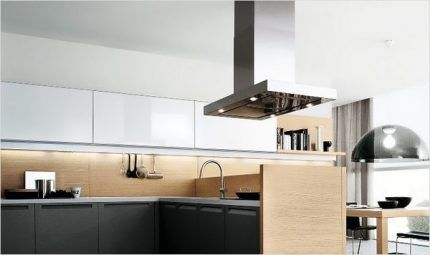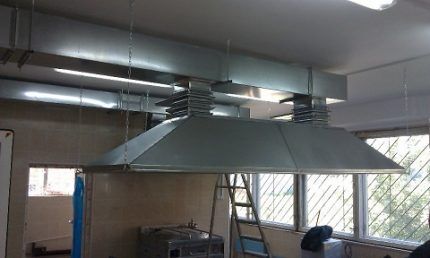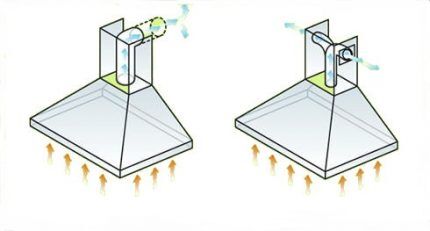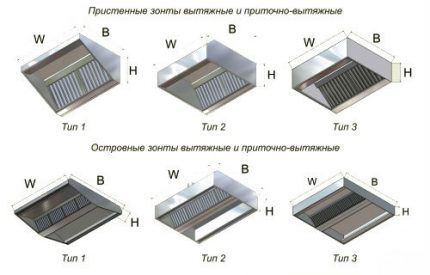Exhaust hood for the kitchen: principle of operation, design, types of units
A necessary element of any serious kitchen is a range hood.Such a device is required to be installed in industrial enterprises, but it also has a worthy place in domestic kitchens.
This hood option is exceptionally effective at removing cooking-related contaminants from the air. Let's take a look together at the operating features of this exhaust hood and the points that you need to pay attention to when choosing a hood for your kitchen.
The content of the article:
How it works?
A device of this type is a powerful hood designed to effectively ventilate air in a kitchen area. They are most often installed directly above cooking surfaces in restaurants, cafes, canteens and other catering establishments.
Such a device can be installed not only over conventional kitchen stoves, but also over other similar equipment: grill, oven, etc.
The quality of dishes will only benefit from the presence of a good hood. Umbrellas trap water vapor, particles of oil and fat, and remove odors emanating from prepared dishes. All these contaminants rise upward under the influence of hot air and enter the working cavity of the ventilation hood. Here, the polluted air passes through a filtration system, where the purification process takes place.

Then the air masses, freed from unnecessary inclusions, are returned to the kitchen area or removed through the ventilation duct, depending on the type of device.
Fatty contaminants move through a separate channel and are collected in storage cups, from which they are periodically removed.

To facilitate the process of cleaning storage units from fat deposits, it is recommended to first pour a special detergent into the glasses that can effectively dissolve fat.
The advantages of umbrella-type exhaust structures include the following:
- the ability to use remote control;
- high degree of automation;
- the ability to install a suitable model in almost any area of the kitchen;
- a wide selection of different models made from various materials with attractive designs;
- high level of productivity.
Among the disadvantages of such equipment, first of all, increased noise generation caused by the operation of a powerful fan is noted. To ensure proper operation of the unit, it must be serviced regularly, i.e. purchase and promptly replace carbon filters.
These items cannot be cleaned or refurbished and may cost more to operate than expected. In addition, good equipment of this type is quite expensive in itself.

Exhaust hoods are always necessary in the kitchen. Particles of grease, hot steam, soot, drops and other contaminants may not be noticeable at first glance, but over time they form a layer of dirt on various surfaces that is not easy to remove.
In addition, gas residues that can enter the kitchen air and the smell of accidentally burnt food are also not good for the health of others.
The design of the ventilation hood is a steel dome-shaped housing, inside of which there is a fan and a set of filtration elements. A special aluminum grille is designed to collect relatively large particles, which protects the ventilation turbine.

An acrylic filter is usually used to remove a significant portion of grease contaminants. In installations with recirculation, it is mandatory to use a carbon filter, which provides fine air purification. The spark-extinguishing mesh protects the elements from overheating and possible fire.
It is especially necessary if the umbrella is installed above a device with an open flame. All filter elements must be periodically cleaned or replaced. Carbon filters are replaced as soon as they become dirty; these elements cannot be restored.
Some types of acrylic filters can be washed and reinstalled, but this treatment quickly causes them to lose their shape, so the number of cleaning and recycling cycles is limited.

A fan or ventilation turbine built into the umbrella ensures air circulation in the right direction with the required intensity. The performance of this element provides the total power of the hood, which should be correlated with the total volume of the room in which it will be installed.
Most umbrella hoods are equipped with lighting, which is very convenient. Such lamps can be used as additional lighting in the kitchen. Along with conventional incandescent lamps, halogen or diode lighting fixtures are built into hoods.
The latter provide a sufficient level of illumination with minimal electrical energy consumption and an increased service life.

If the umbrella is connected to the ventilation duct of the house, it must be equipped with special valves that prevent the air masses entering the device from returning to the kitchen area.
Types of structures and the problem of choice
Based on the type of design, there are wall-mounted and island-mounted exhaust hoods. The design can be exhaust or supply and exhaust. In the first case, the device only removes exhaust air from the room, in the second it also provides an additional influx of fresh air masses.

When choosing a suitable umbrella, you should take into account the required level of air exchange, the size of the cooking equipment, as well as the intended location for its placement. For an industrial kitchen, it is recommended to install a model whose dimensions are 100 mm larger than the dimensions of the hob.
For the manufacture of such devices, food grade stainless steel is used. The device is usually equipped not only with a grease trap, but also with a carbon filter. Backlighting may be a useful option. Supply and exhaust devices, as the name implies, provide not only the removal and purification of polluted kitchen air, but also the influx of fresh air masses from the street.
Such umbrellas are used extremely rarely at home; this is a technique for professional use. Some operations require a constant supply of fresh air. Umbrellas of this type allow you to create an exceptionally favorable microclimate in the workroom, adjust the humidity and air temperature to an acceptable level.
The power of the exhaust element usually exceeds the supply capacity in models of this type by about one third.

Wall umbrellas are mounted not on the ceiling, but on the wall. Typically, such models are used to connect to an exhaust duct. To facilitate installation work, the hob is installed as close as possible to the ventilation duct.
In this case air duct will not be too long, which contributes to the efficient movement of exhaust air into the ventilation duct.

A short design usually does not require many turns when using rigid plastic ducts. There should be no more than three such elbows for one ventilation hood. The beveled type of island hood is very popular, which allows you to bring the hood closer to the maximum permissible distance to the hob.
An island-type umbrella, which is attached to the ceiling, is considered universal. As the name implies, it is used for installation above a kitchen island, specifically above a stove built into it. The peculiarity of the design is that when installing it there is no need to use a wall; the structure is attached to the ceiling.
Such devices are usually used in large kitchens, both industrial and domestic. In small areas, the use of a kitchen umbrella over the island is usually not used due to lack of free space. But such a design may be advisable even in a small kitchen if the hob is installed near a window.
The presence of two filters allows for air purification at a sufficiently high level so that it can be returned to the kitchen area. Of course, the necessary means should be used to ensure sufficient air exchange, but recirculation allows you to retain some of the thermal energy in the room that was spent on cooking.

Recirculation is used in island hoods, since installing such a unit next to a ventilation hatch is usually quite difficult. Read about how recirculating hoods work in this material. Some models of island umbrellas can be adjusted in height, which allows you to change the intensity of absorption of polluted vapors depending on the situation.
If the location for installing the hood is chosen in such a way that the filtered air cannot be discharged into the ventilation duct, then you will definitely have to give preference to a device with recirculation.
When choosing an exhaust hood for the kitchen, you should choose the right one unit performance. The most powerful option is suitable for kitchens up to 25 square meters. m.
However, you should not choose a model with too much power reserve, since the higher the performance, the more noise the hood makes during operation. For a small room this can be a real disaster.

The noise level of the device is considered acceptable around 40 dB. It may be a little higher (up to 70 dB), but you should not choose an overly noisy model, since the sound of its operation can cause irritation. When choosing the type of control, you should take into account the installation height of the device. If the hood is installed high enough, the remote option can be very useful.
This equipment has a high price, so when choosing a brand, you should pay attention not only to the well-known name, but also to the warranty period, as well as the availability of service centers and warranty service conditions. Of course, the design of the device also plays an important role. Fortunately, the models of exhaust hoods are very diverse, you can always find a suitable option.
Features of installation and operation
Installing this type of exhaust equipment is relatively easy, but inexperienced craftsmen are still better off entrusting these operations to professionals. If you decide to carry out the installation yourself, you should start with a detailed study of the manufacturer’s instructions.

After this, you need to examine the installation site, take the necessary measurements, prepare tools, fasteners, materials, etc. An important point is the correct distance from the hob. It must be at least 60 cm for electric stoves and 70 cm for gas appliances, but not more than 85 cm.
If the umbrella needs to be hung higher, then you should choose a more powerful device to compensate for the difference in height. To install an exhaust ventilation hood, you will need tools that are usually in the arsenal of any experienced craftsman: a tape measure and a building level for marking, a screwdriver, a drill, a hammer, etc.
Depending on the type of device, you will need to either simply hang it above the stove, or connect it with an air duct to the ventilation duct.Either a metal corrugated hose or rigid plastic structures are used as an air duct.
The corrugation can be bent in a suitable way, and to make a plastic elbow, special adapters should be used to ensure a tight connection of individual sections of the air duct.
If the power cord is not long enough, you need to install an additional outlet near the device. You need to make sure that the electrical appliance has the necessary grounding.
Proper installation of the ventilation hood is only half the battle. For the device to work effectively, it is necessary to organize its operation. Detailed information on such issues is contained in the operating instructions supplied with each device.
Regular cleaning is essential internal filters. For example, aluminum grilles should be washed using special detergents. A good result is obtained by using products that can be found in any kitchen: acetic acid diluted by a third with water, a saturated solution of ordinary laundry soap, or a paste mixture of water and baking soda.

These recipes will be useful for those who suffer from chemical intolerance. Grates should be cleaned of accumulated grease and dirt at least once every three months.
Replacing carbon filters is usually done in the following order:
- disconnecting the device from the power supply;
- dismantling aluminum grilles;
- removing the used filter;
- installation of a new filter element;
- installation of aluminum grilles;
- connecting and checking the operation of the device.
When installing a new filter, you should hear a characteristic click. If, after replacing the filter, unusual sounds appear in the operation of the hood or it becomes noisier, the filter may be installed incorrectly and the work should be redone.
If cleaning and replacing the ventilation hood filters is not carried out in a timely manner, the performance of the device may significantly deteriorate.

Removable filters and glasses for collecting grease in umbrella models that are used in catering establishments should be cleaned daily in accordance with the instructions. It is also necessary to constantly clean the outer surface of the exhaust housing. It is recommended to remove some elements and soak them in special cleaning solutions.
Once cleaning is complete, rinse them thoroughly. Another element that needs periodic cleaning is the air duct. It is necessary to remove the connecting elements and remove deposits from the internal surface of the structure.
Corrugated elements require this cleaning more often than smooth plastic channels. Some industrial models of kitchen umbrellas are equipped with a built-in cleaning system, but such expensive units are usually not used in everyday life.
Conclusions and useful video on the topic
This video shows the principle of operation of such structures:
Recommendations for increasing the efficiency of ventilation hoods are explained in this video:
An exhaust hood can ensure proper air exchange in both a conventional and industrial kitchen.Proper installation and regular maintenance will ensure long-term and uninterrupted operation of such a device.
Perhaps you recently purchased a new model of kitchen hood and can share your impressions of its operation? Please leave your comments, share your experiences and valuable tips in the block below.




In my sad experience, it’s better not to skimp on exhaust hoods! I had two island ones. The first one was taken solely because of the low price, it was of zero use, it hummed so loudly that the walls shook, and besides, it did not protect the ceiling and walls one percent from yellow plaque and burning. After 2 years of torment, I changed it to an expensive “brand” one - it’s heaven and earth. Absorbs unpleasant odors during cooking and prevents evaporating fat from settling and floating in space. The main thing is not to spare money, it’s a necessary thing.
The same story! A cheap umbrella will make noise. And it would be okay if only this was the case, I would have tolerated it, but it does not protect well from attacks. Moreover, cheapness is a relative concept; it can cost 10 thousand and still work poorly. You must buy from a company store, and the products must be from a well-known company. It is expensive, but it does its job perfectly and the noise level does not exceed 40 decibels.
Alexandra, hello. By exhaust hood we mean a hood, right? Which models (brands) are considered high quality?
Good afternoon. Based on what rules and regulations was this article created? If you have links to the material, please provide them.
Hello.This article is positioned as material with practical advice, and not as technical instructions. This means that there was no need to refer to standards and SNiPs.
First of all, I can note that at the moment, according to the laws of the Russian Federation, exhaust hoods are not subject to mandatory certification, so manufacturers use their own methodology for calculations. This means that this ventilation equipment is selected for specific stoves or stoves, and the calculation rules are reduced to practical experience and standards.
And again, in this case there are recommendations, not requirements and standards. For example, ABOK recommendations 7.3-2007 “Ventilation of hot shops of public catering establishments.” This is a book of 20 pages, from it you can find out all the necessary information that interests you.
Hello. I want to install a restaurant-type exhaust hood in my apartment. Question: which motor/fan should I choose? You need a productivity of 1000 cubic meters per hour and an acceptable noise level.
There are such fans on the market, but it is not entirely clear how they will work with hot air from the hood. In addition, how do you understand whether you need to install the fan directly next to the exhaust hood or closer to the ventilation duct?
Hello, Ilya. You should not install the fan in close proximity to the exhaust hood. I will attach for you a photo of the installation of the exhaust hood and the location of the fan, this will be relevant for you.
Just do not allow the fan power to be reduced due to an excessively narrow ventilation duct at the point where it is connected to the umbrella itself.I noticed that even many craftsmen who specialize in installing household ventilation equipment now make such a banal mistake.
As for operating temperatures, industrial fans are not afraid of hot air. I can recommend several good models:
— DOSPEL WK 200 (industrial channel centrifugal);
— Duct fan Soler & Palau TD-500/150.
The latter costs more, about 200+ dollars, the price of the first is about 150 dollars. Soler & Palau has a fairly low noise level.
Alexey, good afternoon. Tell me, in apartment conditions, is it possible to install an umbrella covering two work areas, an open grill and a hob? Or is this not advisable? I personally am not yet sure that a household hood can cope with the “exhaust” of an open grill. Thank you!
In my apartment building, built according to a Finnish design, the exhaust ventilation in the kitchen is active, i.e. with roof fan.
It pulls very hard, you can even hear it. According to the developer’s recommendation, it is not advisable to install a motorized hood in the kitchen, but I don’t see any passive exhaust hoods with an acceptable design for a home, not a restaurant, for sale. Although I know that in “different Europes” they have this for houses with roof fans. I don't want to install recirculation.
And in a good way, it is necessary that there be a mechanical valve at the umbrella to regulate the flow.
What do you advise?